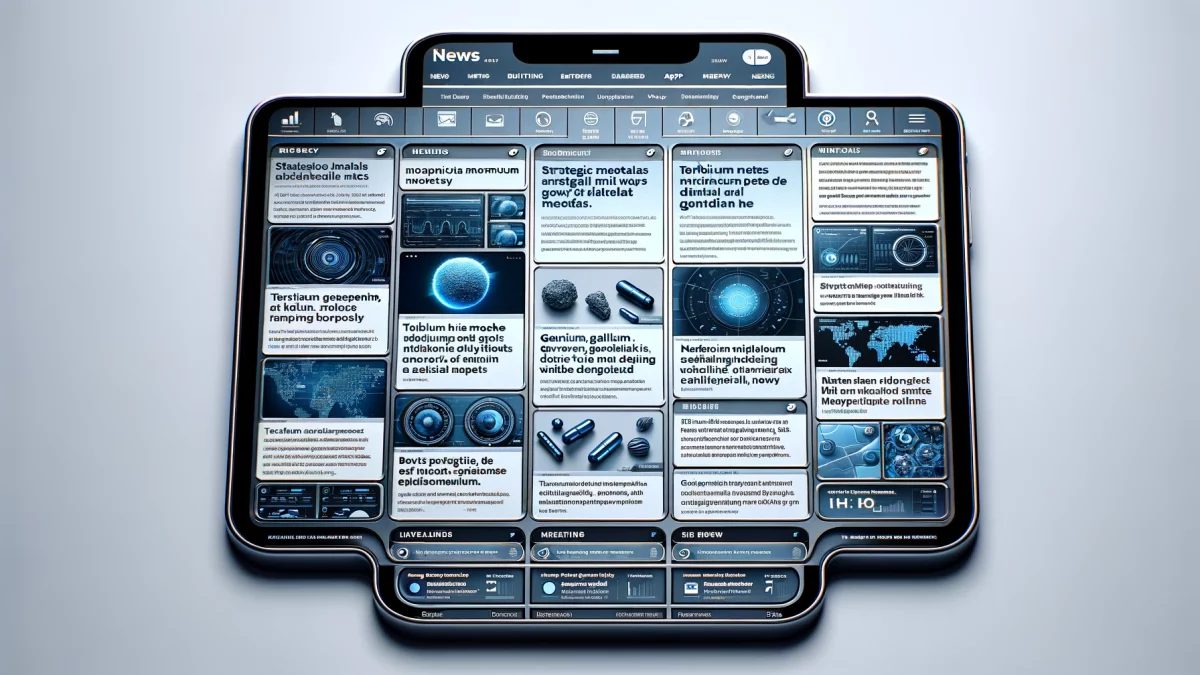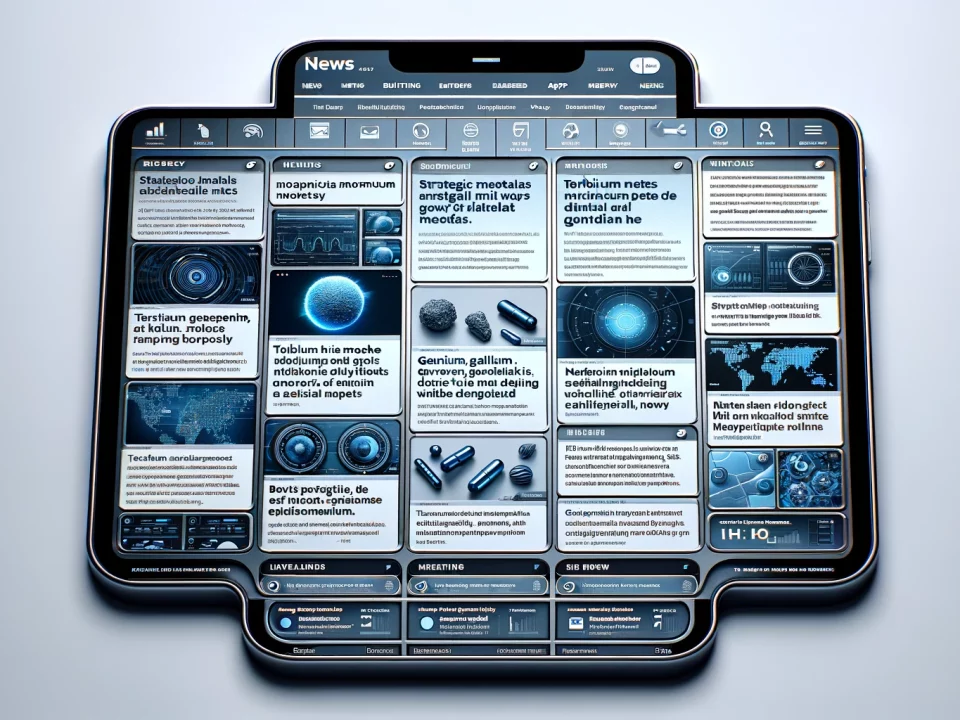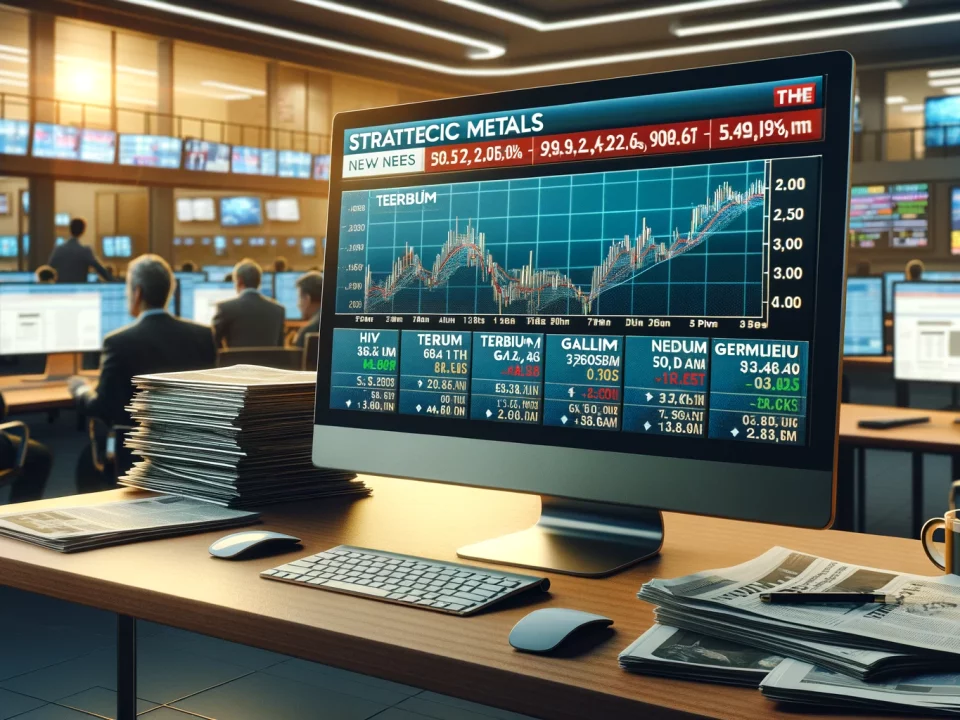
Weekly News Review October 28 – November 3 2024
November 3, 2024Terbium Price Forecast 2025: Why This Rare Earth is Poised for a Rebound
November 12, 2024China issued the first batch of economic data for October this week, including figures for the export of rare earths. Meanwhile, rare earth mining in neighboring Myanmar has reportedly come to a standstill, presumably because of an ongoing domestic conflict.
Find out the details and what else happened this week in our roundup.
MYANMAR: MINING DISRUPTION LIKELY TO CAUSE SHORTAGES OF RARE EARTHS –
According to the Chinese newspaper Global Times, there are signs of a potential shortage in the supply of rare earths from Myanmar. The state-affiliated newspaper reports that mining activities in the neighboring country are suspended.
Myanmar mainly supplies medium rare earths like gadolinium and heavy rare earths like terbium to China, where they are further processed. About 50 percent of the world’s production of heavy rare earths comes from Myanmar.
The newspaper provides no details on the reasons for the suspension of mining. The background may be the conflict between the junta, which seized power in February 2021, and rebel groups. One of these armed groups recently reported gaining control of an essential rare earth mining center in the country’s north.
CANADA: NEO SECURES $50 MILLION TO ADVANCE ESTONIAN MAGNET FACILITY –
Toronto-based Neo Performance Materials has secured up to $50 million in loans from Export Development Canada to advance the construction of its sintered rare earth magnet facility in Narva, Estonia. The plant, which will be completed next year, will have an initial annual production capacity of 2,000 tons of magnets. With the facility, Neo mainly aims to supply the European and North American electric vehicle markets.
A major European car manufacturer ordered roughly 35% of the production volume in August. Neo’s President and Chief Executive Officer, Rahim Suleman, said the plant will “service the growing demand for localized, parallel supply chains, shaping the future of EV manufacturing in Europe and North America.”
In the press statement, the company also highlighted the magnet factory’s strategic location: It is close to its rare earth separation facility in Sillamäe, facilitating the transport of feedstock material to the new plant.
EUROPE: RUTHENIUM OFFERS NOVEL APPROACH TO CANCER TREATMENT –
The international research team develops methods that could aid in treating previously untreatable tumors.
The precious metal ruthenium could potentially aid in cancer treatment in the future, even working in cases where current therapies reach their limits. Conventional drugs require oxygen to be effective – a challenge since many tumors have low-oxygen regions within them, explains Dr. Johannes Karges of Ruhr University Bochum.
These regions form because tumors proliferate, consuming a lot of oxygen, while their blood vessel growth cannot always keep up. Karges and an international research team are developing a new method that operates independently of oxygen levels. This method uses ruthenium-based nanocatalysts that oxidize glutathione, a tripeptide essential for cancer cell survival, thereby neutralizing it.
While all cells rely on glutathione, Karges explains that the catalyst acts selectively because it is encased in polymer nanoparticles, which specifically accumulate in tumor tissue. According to the publication in Nature Communications, previous metal-based catalytic drugs typically lacked strong cancer selectivity.
The effectiveness of this newly developed method has been demonstrated in experiments on cancer cells and animal models: In mice with tumor types considered incurable in humans, the cancer tissue was nearly eliminated. These promising results require further studies to confirm their effectiveness before potential human applications can be considered.
CANADA: MANITOBA ADMINISTRATION PUBLISHES STRATEGIC METALS STRATEGY –
The province is establishing a new Critical Minerals Office, speeding up the permitting stages, and offering tax credits. It seeks to position itself as a raw materials supplier.
The Canadian province of Manitoba has published a strategy to attract companies and advance its critical minerals sector. According to the document, the provincial government seeks to combine an acceleration of mining and processing projects while conserving the environment. Manitoba Economic Development Minister Jamie Moses said the strategy “will solidify Manitoba as a world leader in responsible mineral development.
Under the initiative, the province will launch a new Critical Minerals Office and Permit Office, which will collaborate with other government branches to streamline permitting steps, facilitate investments in the province, and provide companies with needed information.
The government highlighted that Manitoba is home to 30 of the 34 minerals on Canada’s 2024 critical minerals list, including all six that have been prioritized for economic prosperity and growth and their importance for supply chains: cobalt, copper, graphite, lithium, nickel, and rare earth elements.
The government also highlighted that various tax credits and incentives for mineral production exist in the province already and hinted at more to come. “Manitoba is ready to provide the critical minerals the world needs,” Minister Moses said.
New Push Aligns With Canada’s Federal Strategy – Manitoba Has a Sizeable Mineral Industry Already:
Manitoba already has a substantial mineral industry. In 2022, the province accounted for 30.7 percent of Canada’s zinc production, 8.1 percent of Canada’s nickel production, and 100 percent of Canada’s cesium and lithium production.
In 2024, Manitoba will remain home to one of only two lithium mines in North America. In addition, 45 active exploration and development companies are currently exploring critical mineral deposits in Manitoba.
Manitoba’s mineral push aligns with Canada’s federal plans to ramp up its mining and processing capacities. In September 2023, the federal government published a strategy to position the country as an alternative raw materials supplier to industry leader China. Key aspects of this strategy are faster-permitting stages and the build-up of the necessary infrastructure, such as roads, railways, and electricity.
AUSTRALIA: MOU SIGNED FOR SOUTH AMERICA’S FIRST MAGNET LABORATORY –
Viridion, a joint venture between the Australian mining companies Ionic Rare Earths and Viridis Mining and Minerals, signed a Memorandum of Understanding with the Brazilian SENAI FIEMG Innovation and Technology Centre.
SENAI stands for Serviço Nacional de Aprendizagem Industrial, which roughly translates to National Service for Industrial Training. The organization provides training for specialized workers in mining and chemical engineering fields. The center is developing South America’s first rare earth magnet production facility, Lab Fab.
Under the five-year agreement, the two sides will seek to outline supply agreements for a pilot rare earth magnet plant, conduct joint research on supply chains, and explore other areas of cooperation, such as consultancy or training. Ionic and Viridis launched Viridion in April (PDF). The joint venture plans to source rare earth raw material from Viridis’ Colossus project in the Eastern state of Minas Gerais and use Ionic’s processing technology and methods to produce rare earths suitable for magnet production.
These could then supply the magnet-making facility. Lab Fab plans to begin initial production stages in the following months with a targeted production of 100 tons of rare earth magnets annually by 2026. The magnet maker aims to double this within three years.
This marks the third agreement between Lab Fab and mining companies.
In June, fellow Australia-based mining company Meteoric Resources signed a similar deal over feedstock material from Meteoric’s Caldeira rare earth project in Minas Gerais. In September, Brazilian Critical Minerals, which is developing a rare earth project in Northern Brazil, also signed such a memorandum with the technology center.
CHINA: DESPITE EXPORT RESTRICTIONS CHINA SHIPS MORE RARE EARTHS –
Conflict in the mining region of neighboring Myanmar stirs uncertainties in the industry.
China launched a set of regulations regarding the export of rare earth elements in October. However, a possible decline or even temporary halt in exports, as was seen with gallium and germanium—whose export is tied to more stringent restrictions—has not yet occurred with rare earths. Recent data from the Chinese customs authority show an increase of nearly 14 percent in the past month compared to September, reaching 4,753 tons. Compared to last year’s month, ten percent more of this resource group was exported abroad.
UNITED STATES: MP MATERIALS REPORTS AN INCREASE IN REVENUE AND OVERALL LOSS –
MP Materials reports a 20% increase in revenue for the third quarter to $62 million compared to the same period last year. The U.S. company specializing in mining and processing rare earth elements attributes this revenue jump primarily to higher production volumes and more robust sales. The company sold 9,729 tons of material in the third quarter.
However, increased production costs and expenses related to expanding operations, such as the construction of a magnet factory in Fort Worth, Texas, ultimately led to a loss. Nevertheless, according to Reuters, this loss was smaller than analysts had expected. The company also slightly improved compared to the third quarter of 2023.
Like the Australian company Lynas, another key player in the rare earth industry outside of China, MP, the operator of the Mountain Pass mine in California, emphasized in its quarterly report the currently low price levels for raw materials.
AUSTRALIA: LYNAS OFFICIALLY LAUNCHES RARE EARTHS PROCESSING PLANT –
Australian rare earth giant Lynas has officially launched its processing facility in Kalgoorlie, Western Australia. Last December, the plant began initial production steps and has now ceremoniously launched following a ramp-up.
As a central element to its growth plan, “Lynas 2025,” first announced in 2019, the plant will serve as a bridge between its mining operations at Mt Weld and its separation plant in Malaysia.
The Kalgoorlie processing facility in Malaysia produces mixed rare earth carbonate, separated into individual rare earths. The company said that Lynas is also developing a heavy rare earth separation plant in Texas, which the Kalgoorlie facility could also supply in the future.
Lynas CEO Amanda Lacaze thanked the Australian government for supporting the plant and highlighted its importance for supply chains outside of industry leader China. The Chamber of Minerals and Energy of Western Australia (CME) welcomed the opening of Lynas’ new plant, highlighting that it “is the first of its kind in the country and will play a vital role in building supply chain resilience.”
CHINA: RESEARCHERS DEVELOP INDIUM-BASED SENSOR TO DETECT LUNG CANCER –
A novel device based on indium oxide and platinum aims to improve early diagnosis.
The air we exhale can reveal our health and even indicate diseases. For example, a reduced concentration of the hydrocarbon isoprene may suggest lung cancer. A research team led by China’s Zhejiang University has developed a nano-sensor specifically for this application, aiming to enable early diagnosis and improve the chances of recovery.
Based on different metals, including platinum and indium, the device is significantly more sensitive than previous isoprene sensors, with a detection limit of only two parts per billion, according to a study published in ACS Sensors. It is also highly selective, can distinguish isoprene effectively from other volatile substances, and tolerates the natural humidity in breath. This meets the strict requirements for lung cancer screening.
“Breakthrough for Non-Invasive Screening”
The researchers have advanced indium oxide-based sensors, which showed promise in earlier trials, as Genetic Engineering & Biotechnology News reported. Platinum nanoclusters play a vital role as a catalyst in activating isoprene detection.
The sensor’s practical effectiveness was tested by being integrated into a portable device that directly displays the concentration of the compound. It successfully distinguished between lung cancer patients and healthy individuals.
According to the researchers, this new sensor technology could be a breakthrough for non-invasive lung cancer screening, enabling fast and affordable diagnoses. However, further research is needed for commercialization, such as in sensor materials, data analysis, and integration into portable devices.
If you would like to learn more about the benefits of owning strategic metals as physical assets, then contact us for a free, no-obligation online presentation at your convenience.






